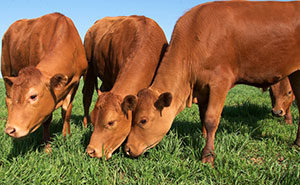Microbiologist Elizabeth Rieder with the Agricultural Research Service (ARS) Foreign Animal Disease Research Unit, located at the Plum Island Animal Disease Center at Orient Point, New York, designed a technique to make FMD vaccine without the need for virulent virus.
She and her colleagues identified a virus DNA sequence that, if removed, makes the FMD virus harmless to animals, but still allows it to grow in cell culture.
The researchers used this DNA sequence to alter the FMD virus, which allowed them to learn more about how the virus functions. They studied how the virus amplifies itself, interacts with host animals, and inhibits the animal's defense mechanisms.
The technology was used in studies to produce a novel marker FMD vaccine that does not require virulent virus. Instead, it uses an attenuated, or weakened, FMD virus that does not cause disease. It is safer than traditional vaccine production methods (chemical inactivation) that use naturally occurring FMD virus strains.
Rieder also labeled the virus used in the new vaccine so that it can be distinguished from other naturally occurring viruses found in outbreaks.
A private company is in the process of developing the ARS technology for vaccine production.
Read more about this research in the October 2013 issue of Agricultural Research magazine.
ARS is the USDA's principal intramural scientific research agency, and this research supports the USDA priority of promoting international food security. ![]()
—Sandra Avant is a public affairs specialist for USDA Animal Research Science.
PHOTO
New techniques to fight FMD in cattle include a smaller need for the virulent virus. Photo by Stephen Ausmus, courtesy of the USDA.









